From The CRPG Addict
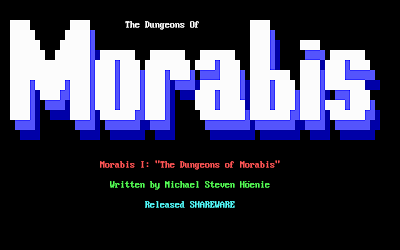 |
There’s some title confusion (covered later). I suppose the title is technically The Dungeons of Morabis: Morabis I: “The Dungeons of Morabis.”
|
Morabis I: The Dungeons of Morabis
United States
Independently developed and released as shareware
Several versions released for DOS between 1991 and 1992
Date Started: 2 May 2020
The CRPG world probably has more roguelike games than the player base can sensibly support, particularly when you consider that even the best examples of the genre are 1) free; and 2) replayable by design. (For those readers unfamiliar with
Rogue and roguelikes, a trip to my
glossary might help.) Roguelikes are almost all about mechanics; it’s not like you keep seeking out new ones for their stories. For a rogue clone to be worth playing instead of the original
Rogue (1980), it has to offer something substantially new or different.
I’m on the fence as to whether
Morabis I does that. Starting with a clear base in
Rogue, it makes some major and minor changes, adds some major and minor features. So far, as many of them have been bad as good. Perhaps the most notable is a quasi-“real-time” gameplay mechanic by which your turn “passes” every second unless you act quickly. One of the features of roguelikes has always been how the turn-based nature of gameplay requires you to really think, so I don’t like that this one pressures you into quick action. Second,
Morabis adds bigger dungeon levels.
Much bigger. It takes about 30 minutes to fully explore a level. This makes the game longer but not more challenging.
Third, while it retains the roguelike randomization of wands, rings, scrolls, et. al. into different colors and descriptions, it doesn’t maintain consistency in those descriptions. One silver ring might be a Ring of Protection but the next is a Ring of Invisibility, or a Scroll of Identification might be described as a red scroll on one level and an ancient scroll on the next. This is the sort of idea that might sound good if you fundamentally don’t understand roguelikes. Finally, there’s a search/hidden area dynamic that would have killed the entire genre if Rogue had featured it in 1980. It would have led me to ragequit after the second level if I hadn’t been forced to write about the game for some jackass’s blog.
Some of the facts of the game are hard to nail down. It was created by Michael S. Höenie (pronounced “Hay-Knee” according to the manual) of Salt Lake City and dedicated to his father. Depending on what web site or document you read, this game might be called Morabis, Morabis I: Quest for the Amulet of Sae’Gore, The Dungeons of Morabis: The Quest for the Amulet, or even Morabis II. Complicating matters is the fact that Höenie apparently wrote several versions between 1989 and 1992. I get the impression that at some point he felt the game had evolved enough to be a II rather than the original, but then later reversed himself. I could be wrong. It’s confusing. The manual that comes with the game titled Morabis I lists commands that are supposedly available in Morabis I but not the original Morabis, but they don’t actually work in Morabis I. Those commands include the ability to talk and transact with monsters, to cast spells, and to dig for treasure. It would be nice if they worked, if they ever did, as this version is a little poorer for their absence.
The backstory is more elaborate than the typical roguelike but ends up being somewhat nonsensical. It tells of a peaceful land being conquered by the evil Lord Devenon, who rules from Castle Morabis. In the final battle, good King Richards is slain, and his son, now King Daniel, vows to find the legendary Scarlette Sword and Armor of Power. Cut to character creation, where the character can be named anything, and he’s questing for the Amulet of Sae’Gore (unmentioned in the backstory) in the dungeons of Morabis. If you try to back out of the dungeon on the first screen, you’re told you can’t leave until you’ve destroyed the “deamon” (misspellings are rampant in the documentation, too) Satu’Nävas. Höenie really likes his umlauts.
After you name your character, the game rolls values for strength, dexterity, and starting vitality, then you’re sent to the first room of the first level of a 25-level dungeon. If I’ve interpreted things correctly, the dungeon levels are not randomized, although the placement of items and some monsters is. Some encounters are fixed, however; for instance, the second room is always full of ghosts that blink in and out of visibility.
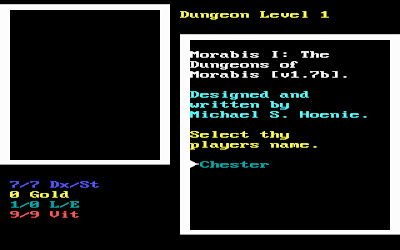 |
| A brief character creation process. |
The game has some minor innovations that do improve upon typical roguelike gameplay. Neither you nor enemies can attack on the diagonal, so if you’re facing a roomful of foes from a doorway, only the one directly in front of you can hit. Shooting with a missile weapon brings up a targeting cursor that lets you aim at any square in range, whether it has an enemy or not, and it will strike whatever it intercepts first. Balancing this: missile weapons are a bit under-powered and you have to hit the “A” key before every melee attack–you can’t just shove your way into enemies.
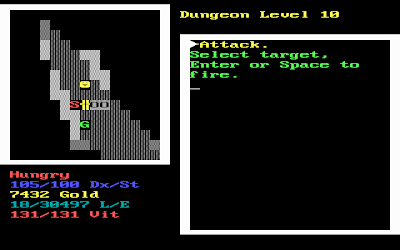 |
| Aiming at several foes with the targeting cursor. |
There are about 35 monsters in the game. Originality is shown mostly with monster names that sound familiar but are a little different: gobnors and hobnorlins, kesthorns, ints, omnorfs, and wraglors. There are alongside more familiar snakes, spiders, ghouls, and ghosts. The monsters don’t have as many special attacks some roguelikes, but occasionally the author’s creativity surprises you. “Dust fiends” are capable of hurling little blasts of dust that cause confusion, for instance. “Ice warfs” can throw balls of ice. Dragons breathe fireballs.
Like most roguelikes, Morabis assigns a letter to objects that you pick up, including weapons, armor, rings, scrolls, wands, food, and keys. Equipping weapons shows their “to hit” and damage values, and equipping armor shows its armor class, but wearable items might be cursed, meaning you can’t take them off until you find a way to remove them. Food is necessary but plentiful. The game is based on pre-NetHack Rogue, so there’s no intrinsics and no eating of corpses to get benefits. (Corpses sometimes appear randomly as food items, but they’re only for the desperate.) There are a few original items like Wands of Invigorate Monster, Scrolls of Chlorine Blast, and Rings of Double Damage, but most are from the Rogue list. One of the things I like about the game is that when you shoot a missile or wand or the enemy fires a missile at you, an ASCII representation actually travels across the screen, round by round, until it hits. You have time to dodge out of the way of some of these attacks if you’re swift.
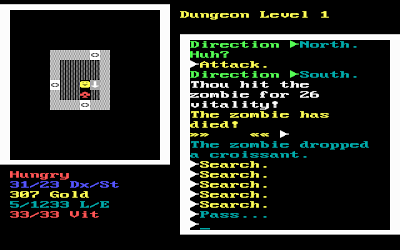 |
| “The zombie dropped a croissant” had me laughing for at least five minutes. |
The difficulty of the game is a bit different than most roguelikes. The level of both monsters and weapons scales as you travel down the levels. On the first level, you might find a sword with +4 accuracy and +9 damage or a chain mail with an AC of 10. By Level 10, you’re finding those figures i the 50s or 60s. So there’s no chance of finding a superb weapon on the first floor and keeping it for the entire game; you must continually replace.
Similarly, your strength and dexterity increase every time you level up, but these increases simply keep pace with the added difficulty of monsters as you go down. In Rogue, an orc is an orc no matter where you meet him; in Morabis, a hobnorlin is significantly more deadly on Level 12 than Level 2. In fact, no matter what level I’m on, no matter what I’m wearing for armor, any enemy seems capable of killing me if they hit me two or three times, and any enemy dies in two or three hits from me.
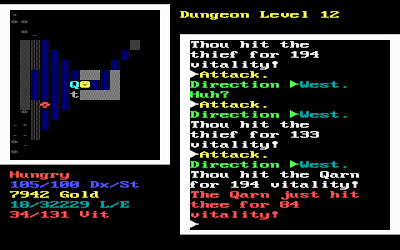 |
| As the levels increase, so does the damage multiplier. |
You have a couple of advantages. Holding down the SPACE key or “S” rapidly regenerates health. Enemies don’t leave their rooms and rarely spawn in corridors, so you can generally rest there safely. Enemies are also pretty miserable at hitting you: their blows land maybe 20% of the time. This gives you time to dart to safety if they hit you once. But most important, Morabis is a “roguelite,” lacking permadeath, allowing you to save anywhere and even saving for you as you change levels.
Thankfully, the author didn’t get creative with commands, copying most of Rogue‘s right down to q)uaff. He actually improved on the typical roguelike when it comes to putting on and taking off objects. In Rogue and NetHack, you have separate commands for equipping and removing weapons and armor and putting on or taking off rings. In Morabis, you just open the inventory screen, highlight the item you want, and hit SPACE to equip or remove it
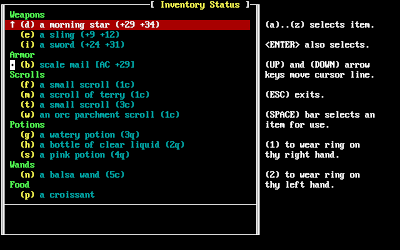 |
| Scrolling through my inventory. |
But for every positive, there’s a negative. There’s no in-game help, for one. The screen doesn’t redraw properly, leaving artifacts all over the place. The “Call” command, which supposedly lets you rename things, doesn’t actually let you see the new names unless you drop the item. Eating poisoned or bad food increases your hunger but often doesn’t actually display it on the screen, meaning you can starve to death with no on-screen warning. An encumbrance bug forces you to occasionally drop all your items and pick them up again to reset your weight. The “more” message, which flashes at the bottom of the screen when there’s more text to show you, remains on the screen and keeps flashing even after you’ve read the text. Small things like that get to you.
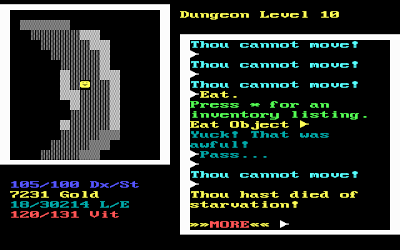 |
| Note that there’s no “hunger” message on my character. |
But nothing is more annoying than the search issue, which is an issue on Level 1 but becomes intolerable on Level 2. On Level 1, most rooms are full of hidden doors. You have to stand in the room and hit S)earch repeatedly–maybe 10 times to be sure–to find all of them. That’s bad enough. But starting on Level 2, entire rooms and passages are concealed, requiring you to hold down the “S” or pound it repeatedly to open up the dungeon, one square at a time. Moving through the dungeon becomes an exercise of hitting “S” after practically every step. I haven’t found it yet, but if there’s a Ring of Automatic Searching, it’s the most valuable object in the game.
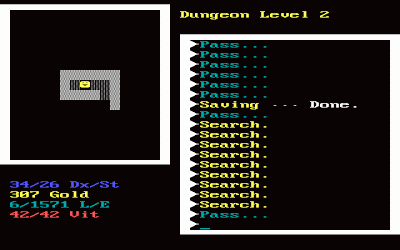 |
| Opening up the dungeon, one “S” key press at a time. |
Anyway, when you’ve come to terms with that, you discover there’s another whole class of secret door you can only find by bumping into blank walls. Another annoyance is that the “search” command never finds traps–nothing seems to–and many of the traps are extremely annoying, chief among them teleport traps which send you to a random point in an already-too-large dungeon level.
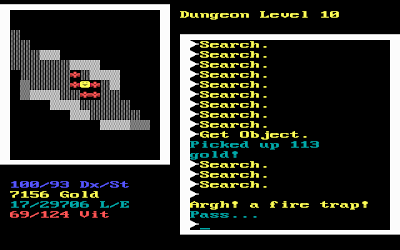 |
| This trap causes fireballs to shoot from all the walls around you and converge on you. |
The lack of randomization of the levels lets the developer lay out some interesting scenes and settings. Unfortunately, a lot of them are annoying and a bit unfair. A common favorite is to require the player to thread his way over a large lava pit on a narrow walkway. Accidentally walking into the lava is instant death. As you walk, traps go off and freeze you in place or you get frozen by ice balls thrown by ice warfs. While you’re froze, dust fiends on nearby platforms blast you, confusing you. While confused, you wander the wrong direction off the platform and instantly die.
 |
| Stuck on a lava walkway while enemies pelt me with missiles. |
Another common setup is to put a secret door at the end of a lava walkway. You sit there like a doofus, hitting s)earch round after round while you’re pelted by missiles from unseen enemies.
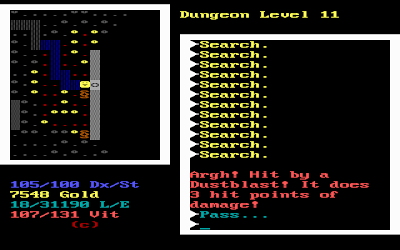 |
| A secret door appears just as I get hit with a dust blast. |
A miniboss comes up every five levels. On Level 5, it was Fennel the Fire Lark, and I faced Jahaÿ the Gobnor on Level 10. Both taunted me with textual taunts as I explored the level and neared their chambers. They’re a little bit harder than generic creatures of those types on the same level, but not overly so. Level 13 brought the game’s first dragon, guarding a pile of treasure in his lair behind him.
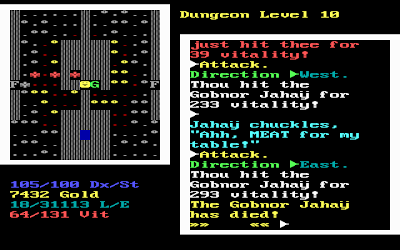 |
| My understanding is that the umlaut over the “y” signifies that the name is pronounced “Ja-ha-ee.” |
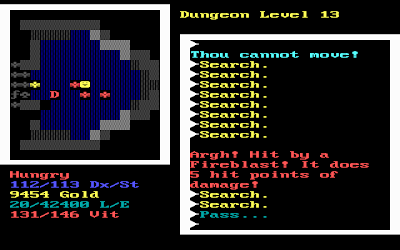 |
| I try to dodge fireblasts while getting in melee range of the dragon. |
I had hoped to win the game in one post, but in my initial six hours, I could only make it to Level 13. This is the first level that has required keys to open doors. The game gives you copious keys of different types but doesn’t require them for the first 12 levels.
 |
| Opening the door with a key. |
Food is starting to get scarce, and I can’t seem to find the next down staircase. But I’ll keep at it, document the ending, and let you know if it offers anything new in its second half.
Time so far: 6 hours
Original URL: http://crpgaddict.blogspot.com/2020/05/game-364-morabis-i-dungeons-of-morabis.html















